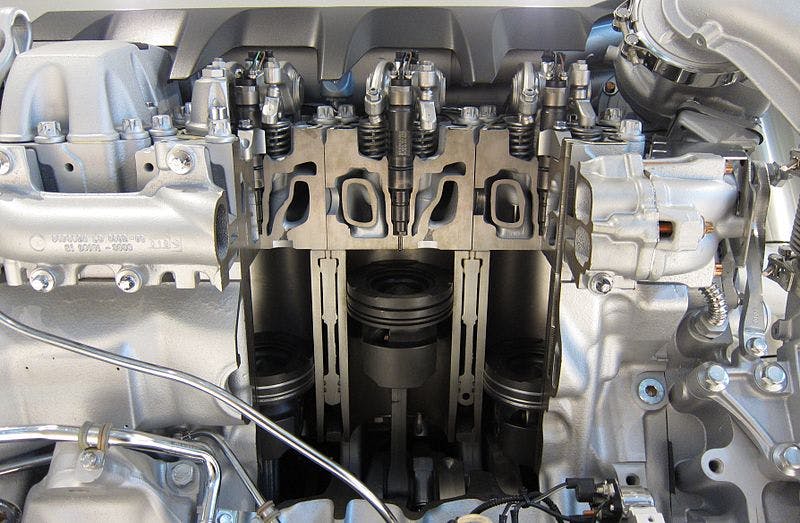Common Rail: How does it work, and what are its advantages?

Common Rail, abbreviated CR, is a fuel injection system for petrol and diesel engines. The Common Rail system is equipped with a high-pressure reservoir that can withstand the high pressure of the fuel pump.
The fuel injected into the cylinder is dispersed through several smaller injector holes requiring higher pressure. The fuel injected in this way forms a better combustible mixture, thanks to which the engine has greater efficiency.
Inhaltsverzeichnis
How does Common Rail work?
Unlike other fuel injection systems, with the Common Rail system, the fuel pressure is created independently of the engine speed and the amount of fuel injected. It is always sufficient, thanks to the high-pressure reservoir.
In conventional systems, the fuel is led from the fuel tank by a pump through a low-pressure line to the high-pressure cylinder pumps. After that, the fuel goes through a high-pressure line directly to the injectors.
The Common Rail system leads the fuel from the high-pressure pump to the pressure reservoir - Rail, which is common for all cylinders. From the reservoir, the fuel is distributed to the individual injectors. There is usually only one high-pressure pump for the CR, but there are usually two for larger engines.
The pump of the Common Rail system must be built to deliver maximum power, a valve maintains the reservoir pressure, and excess fuel is returned to the fuel tank.
History of Common Rail in brief
The first generation Common Rail system (1997) uses a pressure of 1350 bar, the second generation (2001) uses a pressure of 1600 bar, and the third generation (2003) Common Rail reaches a pressure of 1800 bar.
Through gradual improvements, the division of the system into two groups was achieved, depending on the principle used by the injectors. These are piezoelectric or magnetic injectors. The most modern CR systems reach a maximum pressure of 3000 bar.
An increasing number of cars are switching to the CR system. Nowadays, the Common Rail system is produced by BOSCH, Denso, Magneti Marelli, Siemens-VDO, and Delphi.
Advantages of Common Rail Fuel Injection System
The common rail fuel injection system offers several advantages over other fuel injection systems. Some of these advantages include the following:
Improved Fuel Efficiency: The common rail fuel injection system enables precise fuel delivery, resulting in efficient combustion, better fuel economy, and reduced emissions.
Increased Power: The common rail fuel injection system allows for high-pressure fuel injection, improving engine power and performance.
Quieter Operation: The common rail fuel injection system operates at a lower noise level, resulting in a quieter engine operation.
Reduced Emissions: The common rail fuel injection system offers better control over fuel injection, reducing emissions of harmful pollutants.
Components of a Common Rail Fuel Injection System
The common rail fuel injection system consists of several components, including:
High-Pressure Fuel Pump: The high-pressure fuel pump supplies pressurized fuel to the fuel rail.
Fuel Rail: The fuel rail is a high-pressure pipe that distributes fuel to each injector.
Fuel Injectors: The fuel injectors deliver the right amount of fuel into the engine's combustion chamber at the right time.
Electronic Control Unit (ECU): The ECU controls the fuel injection system, including the fuel pressure and timing.
Pressure Sensor: The pressure sensor monitors the fuel pressure in the fuel rail and sends signals to the ECU to adjust fuel pressure and timing.
Temperature Sensor: The temperature sensor monitors the fuel temperature and sends signals to the ECU to adjust fuel pressure and timing.
Designations of diesel engines using the Common Rail system:
BMW - D
Fiat, Alfa Romeo, Lancia - JTD, MultiJet, UniJet, JTDm
Honda - i-CTDi
Ford - TDCi
Chevrolet - VCDi
Mazda - CiTD
Mitsubishi - DI-D
Nissan - NEO-Di
Renault - dCi
Toyota - D-4D
Volkswagen Group - TDI
Petrol engines that use the Common Rail system are called GDI (gasoline direct injection), FSI (fuel-stratified injection), and others.
Conclusion
The common rail fuel injection system is an important part of modern diesel and petrol engines and offers several advantages over other fuel injection systems.